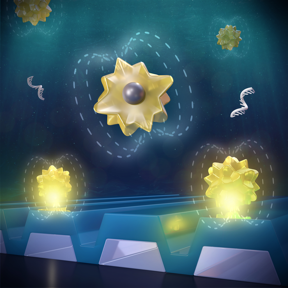Home > Press > Acceleration of cancer biomarker detection for point of care diagnostics
 |
| Computer rendering of the magnetic activate capture+digital counting approach for accelerated digital biodetection
CREDIT Alex David Jerez Roman, Beckman Institute imaging technology group |
Abstract:
The detection and quantification of cancer-associated molecular biomarkers in body fluids, or liquid biopsies, prove minimally invasive in early cancer diagnostics. Researchers at the University of Illinois Urbana-Champaign have developed an approach that accelerates the detection of cancer biomarkers in samples taken at the time and place of patient care.
Acceleration of cancer biomarker detection for point of care diagnostics
Urbana, IL | Posted on January 28th, 2022
The study, published in ACS Nano, focused on the detection of a group of molecular biomarkers called microRNAs (miRNAs), small, single-stranded and noncoding RNAs that play important roles in gene expression and regulation. More importantly, miRNAs have been linked to certain cancer types and stages and as such, have garnered increased attention.
Since tumor-specific mutations in miRNAs can be linked to tumor progression and metastasis, we can use miRNAs for early cancer diagnostics and therapy selection in the future, said Congnyu Che, bioengineering graduate student in the Cunningham lab and first author of the paper. Conventional detection methods take up to several hours for the person to get the result so our motivation was to accelerate the response time and make it shorter.
Previously, the Cunningham group developed a technique to capture miRNA biomarkers, called Photonic Resonator Absorption Microscopy, that is capable of visualizing gold nanoparticles bound to target miRNAs. Using gold-only nanoparticles, it would take between 1-2 hours before the nanoparticles found their way to the biosensor. To accelerate the process, Che synthesized magnetic-plasmonic nanoparticles that incorporated iron materials that could then be attracted by a stationary magnet placed under the biosensor. The detection time was reduced to just one minute.
Our approach has a one-minute response time, which means that the patient or doctor only waits for one minute before finding out the test result, said Che.
If you have a simple, fast and sensitive test like that, it can be used for detecting cancer, monitoring cancer treatment effectiveness, and following up with treatment, said study leader Brian Cunningham (CGD Director/MMG), the Intel Alumni Endowed Chair of Electrical and Computer Engineering. We envision this method being used in a health clinic so you wouldn’t have to take a sample, send it to a lab, and wait several days.
In the study, the researchers focused on miRNAs associated with advanced prostate cancer since they have a collaboration with prostate cancer experts at the Huntsman Cancer Institute in Utah. They demonstrated a faster detection time and high selectivity when using magnetic-plasmonic nanoparticles to detect the miRNAs in human serum.
This approach provides much more rapid sample-to-answer analysis of miRNA biomarkers that are used in cancer, nutrition, cardiac health, and maternal health diagnostics in point-of-care scenarios, said Cunningham.
This work was supported by the IGB, the National Institutes of Health, the National Science Foundation, and the Zhejiang University ZJU-UIUC Joint Research Center.
####
For more information, please click here
Contacts:
Nicholas Vasi
Carl R. Woese Institute for Genomic Biology, University of Illinois at Urbana-Champaign
Office: 217-333-0873
Copyright © Carl R. Woese Institute for Genomic Biology, University of Illinois at Urbana-Champaign
If you have a comment, please Contact us.
Issuers of news releases, not 7th Wave, Inc. or Nanotechnology Now, are solely responsible for the accuracy of the content.
News and information
![]()
Scientists enhance energy storage capacity of graphene supercapacitors via solar heating January 28th, 2022
![]()
HKUST co-led study reveals topology at the corner of the dining table January 28th, 2022
![]()
Shining a light on synthetic dimensions January 28th, 2022
Cancer
![]()
UT Southwestern develops nanotherapeutic to ward off liver cancer January 14th, 2022
Govt.-Legislation/Regulation/Funding/Policy
![]()
Void-confinement effect of nanoreactor promotes heterogeneous catalysis January 28th, 2022
![]()
New approach transports trapped ions to create entangling gates January 28th, 2022
![]()
Shining a light on synthetic dimensions January 28th, 2022
Possible Futures
![]()
Scientists enhance energy storage capacity of graphene supercapacitors via solar heating January 28th, 2022
![]()
Void-confinement effect of nanoreactor promotes heterogeneous catalysis January 28th, 2022
Nanomedicine
![]()
UT Southwestern develops nanotherapeutic to ward off liver cancer January 14th, 2022
Discoveries
![]()
Scientists enhance energy storage capacity of graphene supercapacitors via solar heating January 28th, 2022
![]()
Void-confinement effect of nanoreactor promotes heterogeneous catalysis January 28th, 2022
![]()
2D materials could be used to simulate brain synapses in computers January 28th, 2022
Announcements
![]()
New approach transports trapped ions to create entangling gates January 28th, 2022
![]()
HKUST co-led study reveals topology at the corner of the dining table January 28th, 2022
![]()
Shining a light on synthetic dimensions January 28th, 2022
Interviews/Book Reviews/Essays/Reports/Podcasts/Journals/White papers/Posters
![]()
New approach transports trapped ions to create entangling gates January 28th, 2022
![]()
HKUST co-led study reveals topology at the corner of the dining table January 28th, 2022
Grants/Sponsored Research/Awards/Scholarships/Gifts/Contests/Honors/Records
![]()
Shining a light on synthetic dimensions January 28th, 2022
![]()
NSF funds Rice effort to measure, preserve quantum entanglement: Physicist Guido Pagano wins CAREER Award to develop tools for quantum computing January 14th, 2022
![]()
Nanostructures get complex with electron equivalents: Nanoparticles of two different sizes break away from symmetrical designs January 14th, 2022
![]()
Major instrumentation initiative for research into quantum technologies: Paderborn University receives funding from German Research Foundation December 24th, 2021
Nanobiotechnology
![]()
UT Southwestern develops nanotherapeutic to ward off liver cancer January 14th, 2022










